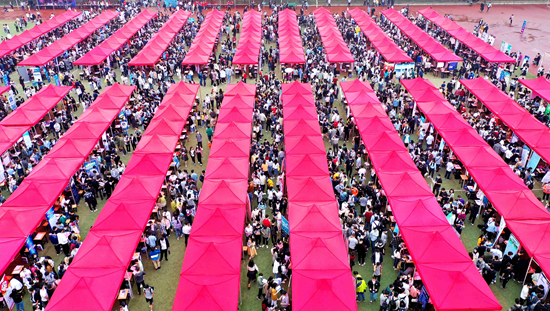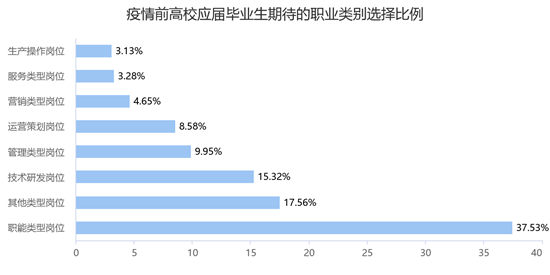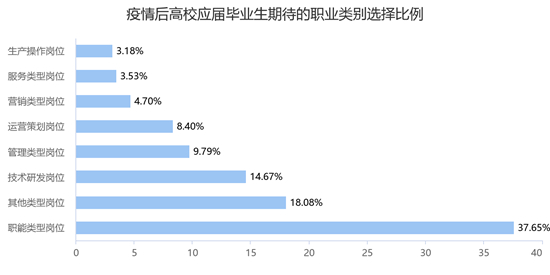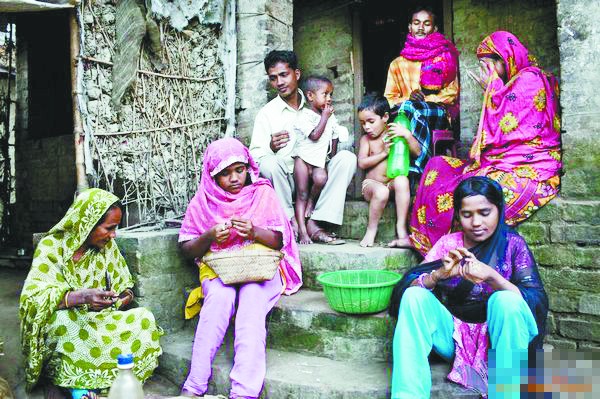Xinhua News Agency, Beijing, May 17th Title: March forward rain or shine —— On the occasion of great strategic achievements in the national epidemic prevention and control war.
Xinhua news agency reporter
As mankind enters the year 2020, history has written another thrilling chapter.
China is making every effort to win a well-off society in an all-round way and fight against poverty; The world, which has not changed in a hundred years, has accelerated its evolution. At this time, a sudden novel coronavirus epidemic swept the world.
What does China do? What about the world?
The CPC Central Committee with the Supreme Leader as the core led the 1.4 billion people in China to make a historic choice: unite as one with "life first", confront major epidemics with the strength of the whole country, and overcome the difficulties with "the community of human destiny".
After tenacious struggle and great sacrifice, China has effectively curbed the spread of the virus and made important contributions to the global war "epidemic".
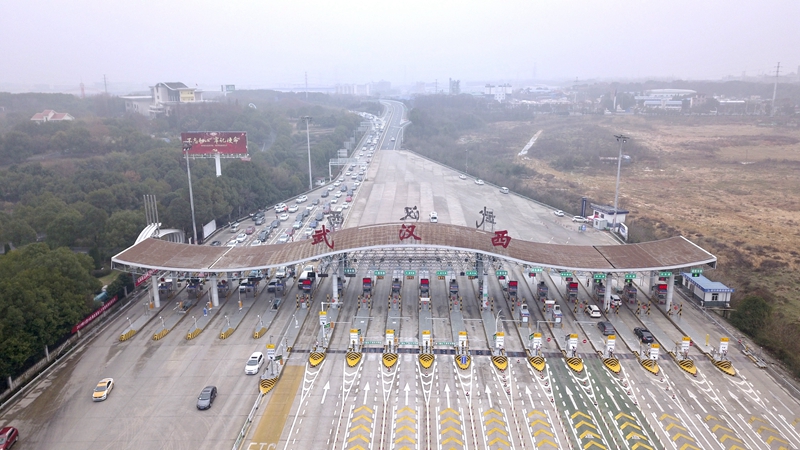
This is the toll station of Wuhan West Expressway (photo taken on January 23, photo of drone). Xinhua News Agency reporter Xiong Qishe
Great plague raid, bold hand, turn the tide in the fall.
"We should put the people’s life safety and physical health first, formulate careful plans, organize all forces to carry out prevention and control, and take practical and effective measures to resolutely curb the spread of the epidemic." -supreme leader
In 2020, I was in Gengzi.
"Seal the city!"
At 10 am on January 23rd, 2020, the last working day before Lunar New Year’s Eve, Wuhan became the center of a battle.
Controlling the flow of people in a city with a population of 10 million is unprecedented in the world. It is also a traditional festival of family reunion, which is even more unusual.
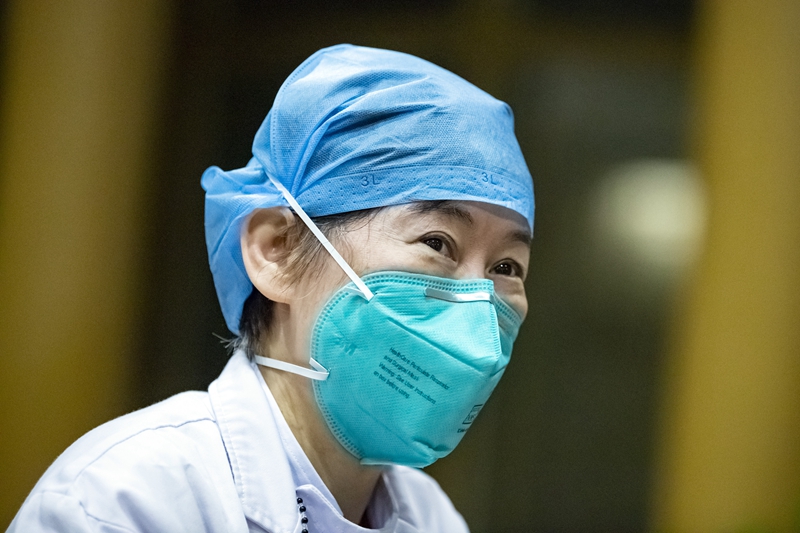
Zhang Jixian, director of the Department of Respiratory and Critical Care Medicine, Hubei Hospital of Integrated Traditional Chinese and Western Medicine (photo taken on March 2). Xinhua News Agency reporter Shen Bohan photo
General Secretary of the Supreme Leader personally made this strategic decision on January 22, and he stressed: "It takes great political courage to make this decision, but when it is time to make a move, it must be made, otherwise it will be interrupted and chaotic."
On January 20th, General Secretary of the Supreme Leader, who was in Yunnan for investigation and research, made important instructions on the epidemic situation in COVID-19, saying, "We should put people’s life safety and physical health first, make careful plans, organize all forces to carry out prevention and control, take practical and effective measures, and resolutely curb the spread of the epidemic."
People first! This is the Communist Party of China (CPC)’s mission, the ruling creed of Supreme Leader General Secretary Nizi here, and the source of power for the whole country to compete with the epidemic.
"People’s lives are more important than Mount Tai! As long as it is responsible for people’s lives, then what costs and consequences must be borne. " Words from the Supreme Leader General Secretary hit the floor.
Deep winter is the season when the virus is easy to spread. The Spring Festival is the time when Spring Festival travel rush is at full throttle. At this time, an unexpected epidemic raided Wuhan, the thoroughfare of nine provinces.
Time, back to New Year’s Eve.

In Wuhan, Hubei Province, in order to ensure that patients have sufficient oxygen supply, Hubei aid doctor Hu Shijie (first from right) pushes an oxygen bottle and escorts an 81-year-old critically ill patient from COVID-19 for CT examination (photo taken on March 20). Xinhua News Agency reporter Wang Yuguo photo
This Spring Festival comes early. On the bank of East Lake in Wuhan, 10,000 lanterns are full of brilliance; In the downtown area, the simmering soup contest is full of fireworks.
However, in this joy and peace, an invisible and intangible "devil" came quietly.
At the end of December 2019, Hubei Hospital of Integrated Traditional Chinese and Western Medicine.
"There is a family of three with the same symptoms. Generally, three people will not get the same disease at the same time, unless it is an infectious disease. " Zhang Jixian, director of the Department of Respiratory and Critical Care Medicine who has experienced SARS treatment, is in a tight heart.
A stream, B stream, syncytial virus, adenovirus, rhinovirus, chlamydia, mycoplasma … A series of tests were done, and the results made her more alert.
Not the flu!
Subsequently, four more patients came, with the same fever and cough and the same lung manifestations.
"This is a disease we have never seen before." An alert thought came out and Zhang Jixian quickly reported to the hospital.
On December 30th, Wuhan Municipal Health and Wellness Commission issued the Emergency Notice on Doing a Good Job in the Treatment of Unknown Pneumonia to the medical institutions under its jurisdiction. The next day, the Wuhan Municipal Health and Wellness Commission released the Bulletin on the Current Pneumonia Epidemic Situation in Our City on the official website, and began to release epidemic information according to law.

This is the Fangcang Hospital of Wuhan Sports Center (photo taken on February 17th). Xinhua News Agency reporter Xiao Yijiu photo
"Patients with unexplained pneumonia in Wu Hanyou …"
In the early morning of December 31, the National Health and Wellness Committee made arrangements and sent working groups and expert groups to Wuhan to guide the handling of the epidemic and conduct on-site investigations.
On January 2, 2020, China CDC and others received the first batch of 4 case specimens from Hubei Province. Since the 3rd, China has regularly informed WHO, relevant countries and regional organizations and Hong Kong, Macao and Taiwan regions of the epidemic situation in a timely and proactive manner.
On January 7th, when General Secretary of the Supreme Leader presided over the The Politburo Standing Committee (PSC) meeting, he put forward clear requirements for the prevention and control of epidemic situation.
With the spread of the epidemic, fever clinics began to get crowded. The CT machine is overloaded, and the diagnosis result given by the doctor is almost the same-the glass-like shadow of the lung.
From early morning till late at night, the medical team lined up in the street.

A domestic Yun -20 large transport plane landed at Wuhan Tianhe Airport (photo taken on February 17). Xinhua News Agency reporter Li Heshe
Soon, the wards are overcrowded, new wards are constantly being opened up, and the protective materials for medical staff are running out. "Requesting support for protective clothing", "Medical masks are in emergency" and "Where are goggles" …
By 24: 00 on January 24, 30 provinces, autonomous regions and municipalities across the country had reported confirmed cases, and the number of confirmed cases exceeded 1,000.
Wuhan is in a hurry! Hubei is in a hurry! China is in a hurry!
The COVID-19 epidemic is a major public health emergency with the fastest spread, the widest infection range and the most difficult prevention and control since the founding of New China.
At this time, China, a large developing country with a population of 1.4 billion, is entering the final year of decisive battle to build a well-off society in an all-round way and fight poverty. To prevent and control the epidemic situation, we should not only control many aspects of the actual national conditions, but also prevent hard-won construction achievements from being wasted, and also prevent unpredictable risks such as economic shutdown and social disorder.
"This is a crisis and a big test."
On January 25th, the first day of New Year’s Day, Huairentang, Zhongnanhai. General Secretary of the Supreme Leader sat with six other CPC members, The Politburo Standing Committee (PSC).
"I wanted to let everyone have a good year. Now that the epidemic situation is urgent, we have to convene everyone to study and deploy this issue together. " The General Secretary of the Supreme Leader said with a dignified expression, "I can’t sleep at night on New Year’s Eve."
Without fear or hesitation, the CPC Central Committee with the Supreme Leader as the core has shouldered the extremely arduous task of fighting the epidemic.
"Life is more important than Mount Tai. The epidemic is an order, and prevention and control is a responsibility. "
"Put people’s life safety and physical health first, and take epidemic prevention and control as the most important task at present."
"As long as we have firm confidence, help each other in the same boat, scientific prevention and control, and precise policy, we will certainly win the epidemic prevention and control war."
It was at this meeting that the CPC Central Committee made a series of major decisions:
Set up a central leading group to deal with the epidemic situation and work under the leadership of The Politburo Standing Committee (PSC);
Send a steering group to Hubei and other areas with serious epidemics to promote the relevant localities to comprehensively strengthen the front-line work of prevention and control;
Hubei Province carries out centralized isolation treatment for all patients, adopts home medical management for all close contacts, and strictly controls the personnel entering and leaving Wuhan;
Go all out to treat infected patients, concentrate patients, experts, resources and treatment …
The epidemic is like fire, and the military orders are like mountains.
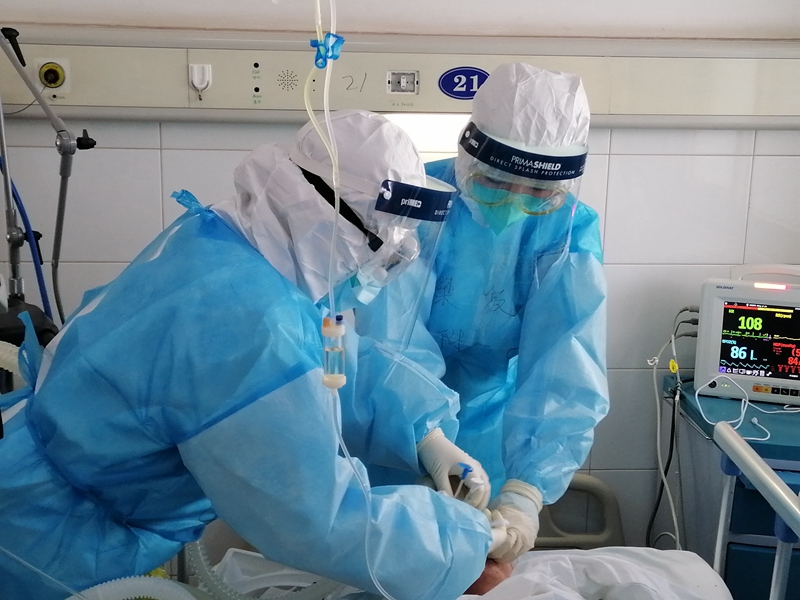
Fujian Province supported the members of Hubei Yichang Medical Team to carry out medical treatment in Yichang Third Hospital (photo taken on February 16). Xinhua News Agency (photo by Zheng Yuliu)
The joint prevention and control mechanism in the State Council has been put into operation, and all localities have launched the first-level response to major public health emergencies, and all party, government, military and group organs, enterprises and institutions have taken urgent action …
Just after the dinner was served, Wang Wei, deputy director of the Department of Critical Care Medicine of Shanghai Sixth People’s Hospital, received a phone call: "Meet at the hospital at 8: 30 tonight and leave for Wuhan."
Almost at the same time—
In Xi ‘an, Hu Shijie, deputy director of neurosurgery at Xijing Hospital of Air Force Military Medical University, sent a message to his father: "Dad, I was transferred to Wuhan to fight virus."
In Guangzhou, Peng Hong, head nurse of the emergency department of the First Affiliated Hospital of Guangzhou Medical University, who participated in the fight against SARS 17 years ago, rushed to the airport.
In Chongqing, Song Caiping, the backbone of nursing in the Second Affiliated Hospital of Army Military Medical University, embraced her 16-year-old son and left him …
When the country is in danger, the mission is the horn.
At a critical juncture, the initial heart is the direction.
Fight! Fight!
Destination: Wuhan!
Under the strong leadership of the CPC Central Committee with the Supreme Leader as the core, a vigorous people’s war, a general war and a blocking war quickly started!
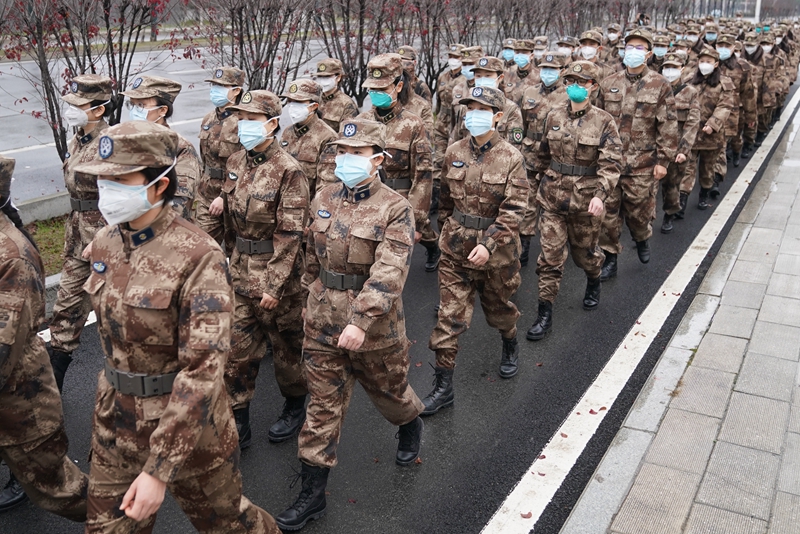
The medical team of the Army Military Medical University began to station in Jinyintan Hospital of Wuhan (photo taken on January 26th). Xinhua News Agency reporter Cheng Minshe
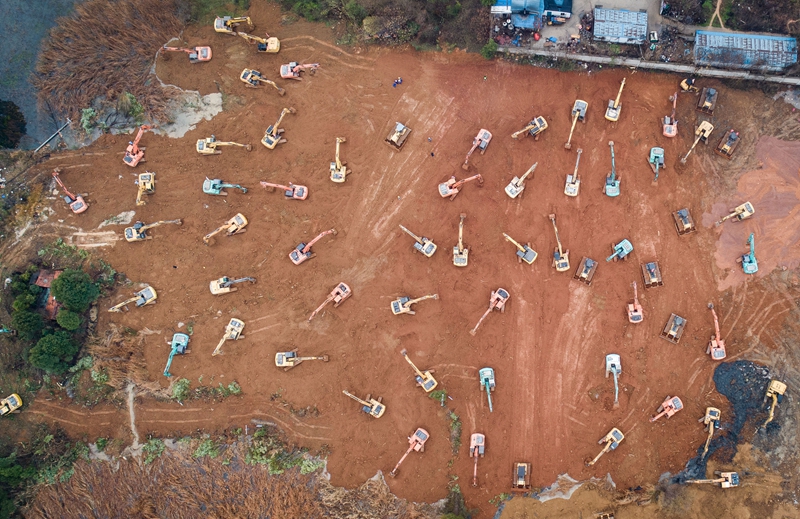
Construction of large machinery at the construction site of Wuhan Huoshenshan Hospital (photo taken on January 24, photo of drone). Xinhua News Agency reporter Xiao Yijiu photo
Strategize, decisive battle, and lay out the "three major battles"
"With confidence, we will fight this war of resistance and total war and this people’s war. We must build up confidence! It will definitely win! " -supreme leader
"If we come later, they may really be unable to hold on." When they arrived at Hankou Hospital, the members of Southern Hospital of Southern Medical University were stunned.
The ever-increasing number of newly confirmed cases has paralyzed Wuhan’s once proud medical system.
The situation is urgent.
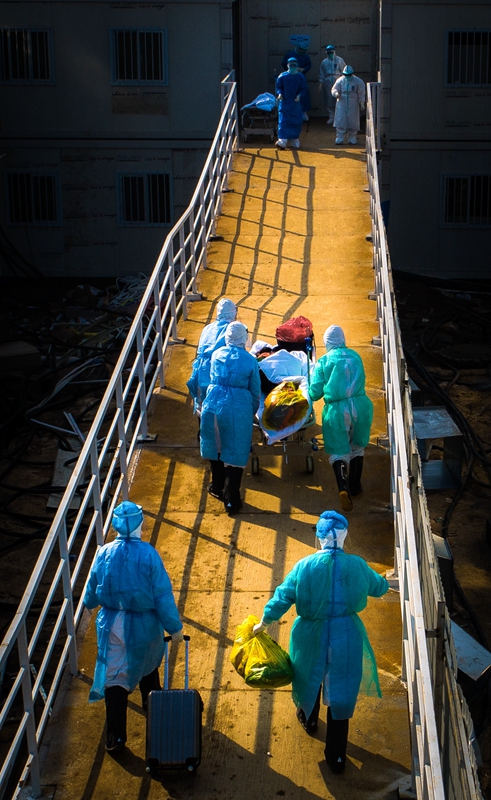
The medical staff went to the ward of Wuhan Huoshenshan Hospital (photo taken on February 4). Xinhua News Agency reporter Xiao Yijiu photo
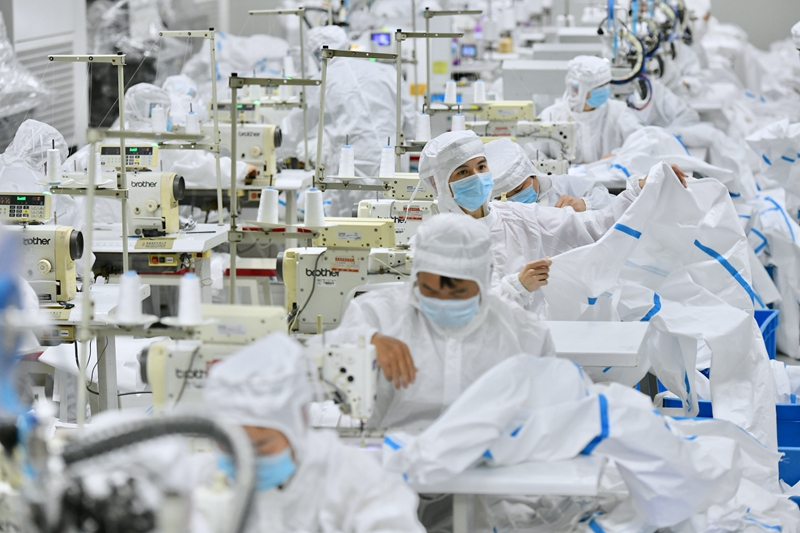
In Jinjiang, Fujian, workers are producing protective clothing (photo taken on February 4). Xinhua News Agency reporter Jiang Kehong photo
Always pay attention to the front-line wars, and the General Secretary of the Supreme Leader gives clear instructions again and again-
"Early detection, early reporting, early isolation and early treatment";
"Take improving the admission rate and cure rate, reducing the infection rate and death rate as outstanding tasks";
"We should take more effective measures to increase the number of beds in medical institutions as soon as possible, make good use of shelter hospitals, increase isolated beds by requisitioning hotels and training centers, and do our best to treat patients";
……
On the third day of New Year’s Eve, entrusted by the General Secretary of the Supreme Leader, Li Keqiang, Premier of the CPC The Politburo Standing Committee (PSC) and the State Council and leader of the Central Leading Group for novel coronavirus’s response to pneumonia, rushed to Wuhan for investigation.
On the same day, the Central Steering Group, led by Committee member the Political Bureau of the Communist Party of China (CPC) Central Committee and Sun Chunlan, Vice Premier of the People’s Republic of China, and composed of responsible comrades of several relevant ministries and commissions, arrived in Wuhan to supervise and supervise the war on the spot.
"If the steering group has any situation or needs, you can call me directly." General Secretary of the Supreme Leader cares about the epidemic situation in Hubei and Wuhan day and night, and has given hundreds of important instructions to the Central Steering Group, which provides a fundamental basis for effectively guiding the prevention and control of the epidemic situation.
14 meetings in The Politburo Standing Committee (PSC), 4 meetings in Politburo meeting of the Chinese Communist Party, 1 meeting of the Central Committee for Comprehensively Administering the Country according to Law, 1 meeting of the Central Cyber Security and Informatization Committee, 2 meetings of the Central Committee for Comprehensively Deepening Reform, 1 meeting of the Central Foreign Affairs Working Committee, 1 symposium for non-party people, 6 visits to local places for investigation and investigation, and 51 calls with foreign leaders and heads of international organizations …
General Secretary of the Supreme Leader personally commanded and deployed. The general mobilization of the party, government, army and people, and the mobilization of the East, West, North and South.
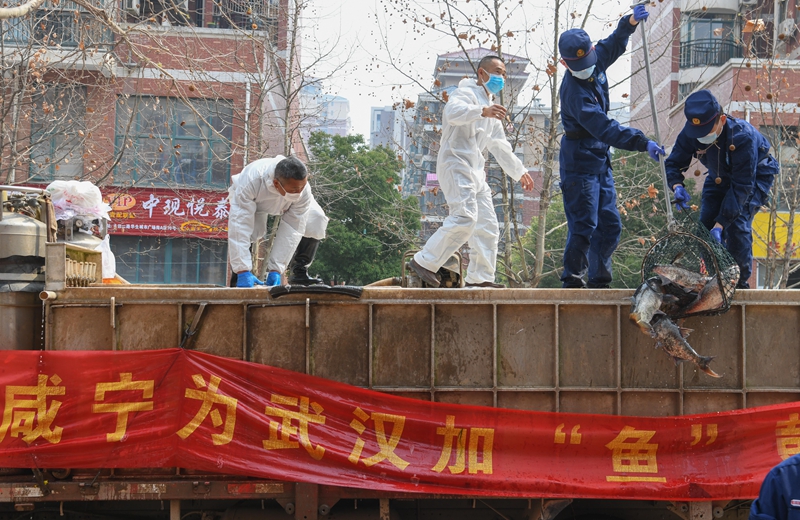
A batch of live fish shipped to the community of Huasheng Hankou City Square in Qiaokou District, Wuhan is unloading (photo taken on March 13). Xinhua News Agency reporter Cheng Minshe
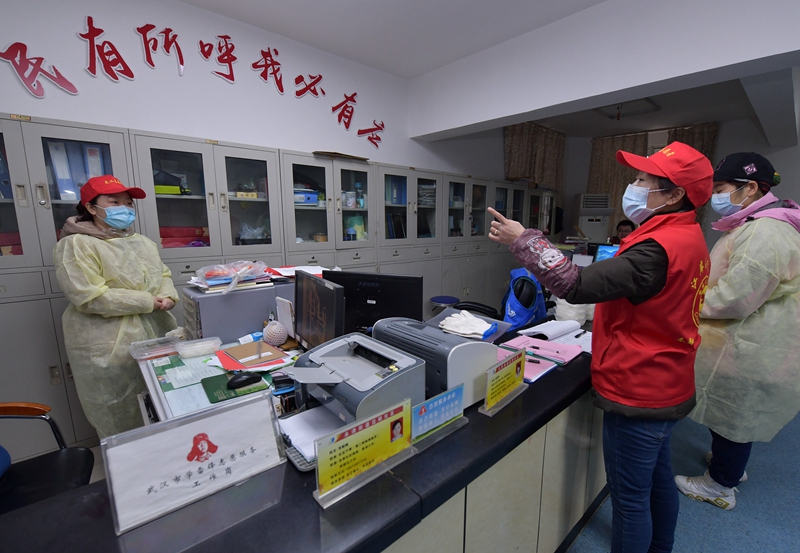
Shenyang community cadre (second from the right) in Yongqing street, Wuhan city assigns work tasks to colleagues in the community office (photo taken on February 12). Xinhua News Agency reporter Li Heshe
-General Secretary of the Supreme Leader issued an order to Party organizations at all levels and cadres in party member: "Do not forget your initiative mind, remember the mission" and "Let party flag fly high in the front line of the epidemic prevention and control struggle".
-the Central Committee of the Communist Party of China issued the Notice on Strengthening the Party’s Leadership and Providing Strong Political Guarantee for Winning the Prevention and Control of Epidemic Situation.
-The Chairman of the Supreme Leader issued an order to the whole army: "Follow orders, bravely shoulder heavy burdens, dare to fight hard and actively support local epidemic prevention and control."
Over 9.6 million square kilometers of land, more than 4.6 million grass-roots party organizations have built solid fortresses. Red party flag, green military uniform and white shirt convey the hope of victory.
There are more than 240 party member in Wuhan Jinyintan Hospital. None of them hesitates or flinches, and all of them stick to their urgent and dangerous posts.

Volunteers in Huajin Community, Wuchang District, Wuhan, distributed love vegetables for community residents (photo taken on February 23). Xinhua News Agency reporter Cheng Minshe
"In order to win the battle against viruses, contribute your own strength, no regrets!" 3306 people from Peking Union Medical College Hospital please fight.
"The most difficult job, the hardest job, party member must go first, no discussion!" A big party with more than 90 million party member members is unswerving and a mainstay.
Under the leadership of the Supreme Leader General Secretary, the Communist Party of party member enthusiastically donated money to express its support for the prevention and control of the epidemic situation in COVID-19. A total of 79.559 million party member volunteers donated 8.36 billion yuan.
Unified leadership and unified command, the Communist Party of China (CPC)’s great energy and power are fully demonstrated; All-round deployment and mobilization, and the institutional advantages of socialism to concentrate on doing great things, difficult things and urgent things are fully released.
"Wuhan wins in Hubei, and Hubei wins in the whole country." The General Secretary of the Supreme Leader scientifically laid out the blocking war and concentrated his firepower on "fighting the defending war in Wuhan and Hubei".
The most elite forces rushed to the eye of the storm, and the best resources gathered in the decisive battle place.
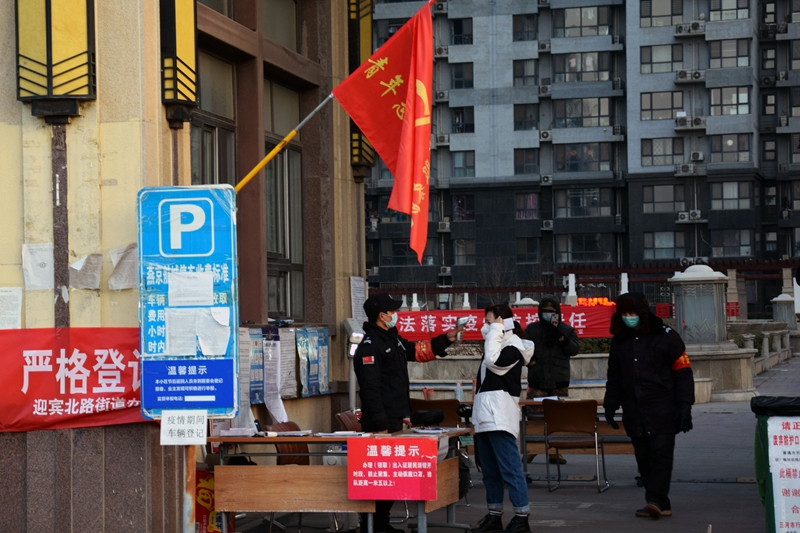
At the entrance of Yanjing Hangcheng Community in sanhe city, Hebei Province, residents are taking temperature tests (photo taken on February 23). Xinhua news agency
Wuhan Tianhe Airport stays around the clock to welcome retrograde personnel and materials.
Less than 8 hours after the "city closure", 4041 epidemic prevention key materials such as epidemic prevention drugs, medical devices, masks and gloves arrived on time in 87 batches.
In less than 24 hours, the medical expert group, the medical rescue team and the PLA officers and men were all ready to go.
Military aircraft, passenger planes, cargo planes … all kinds of aircraft make an emergency landing. At the busiest time, every three minutes, a domestic Yun -20 large transport plane roared.
If one side is in trouble, all sides will support it.
346 medical teams and 42,600 medical personnel from all over the country and the army went out in reverse.
Experts in respiratory and infectious diseases, including many academicians, and 10% of the country’s critically ill medical staff gathered in Wuhan.
19 provinces, autonomous regions and municipalities provide counterpart support to 16 cities and prefectures in Hubei except Wuhan.
This is the China advantage of "a national chess game" and the speed of China-
On the night of January 23rd, the designer of Xiaotangshan Hospital in Beijing who fought against SARS received a call for help from Wuhan Urban and Rural Construction Bureau. 1 hour later, the revised and perfect drawings will be delivered to Wuhan Urban and Rural Construction Bureau for standby; In less than 24 hours, the design institutes of the two places joined hands to form a complete drawing.

At the inspection point in fancheng district, Xiangyang City, Hubei Province, the staff collected a throat swab from a teacher (photo taken on April 18). Xinhua News Agency (photo by Xie Jianfei)
On New Year’s Eve, Vulcan Mountain Hospital broke ground. Three days later, the Thunder God Mountain hospital project was launched.
The two suburbs of the city are like day all night. More than 40,000 builders from all over the country live and eat on beaches and slopes. Hundreds of millions of netizens have become "cloud supervisors."
There is no buffer time, so we can only dig trenches and fight the sniper. Under normal circumstances, it takes at least several months to complete the two infectious disease hospitals, and it only took more than ten days to start the life ferry.
There must be a key move in the critical period!
The epidemic was deadlocked, the CPC Central Committee made a decisive decision, and Hubei and Wuhan changed their positions.
The base is unclear, and the spread can’t stop. The Central Steering Group deployed "all receivables".

Staff showed samples of inactivated novel coronavirus vaccine at China Bio-COVID-19 vaccine production base of Sinopharm Group (photo taken on April 10th). Xinhua News Agency reporter Zhang Yuwei photo
"A large-space, multi-bed’ shelter hospital’ must be activated." Wang Chen, an academician of China Academy of Engineering and an expert in respiratory and critical care medicine, was worried.
Sixteen gymnasiums, convention and exhibition centers and other emergency shelter hospitals were rebuilt, dozens of hospitals were quickly rebuilt, and more than 500 hotels and schools were urgently requisitioned as isolation points … Wuhan gradually realized "waiting for beds" at the rate of adding 3,000 beds every day!
In late January, the analysis and evaluation of critically ill cases found that ECMO (artificial membrane Lung) can win valuable time for the rescue of critically ill patients.
"At all costs, let patients use the best equipment." The request of the Supreme Leader General Secretary turned into an action that stayed up all night.
On the one hand, urgently issue procurement plans to global manufacturers; On the one hand, from the existing 400 machines in hospitals all over the country.
In less than a month, there were more than 100 centralized machines in Hubei Province, of which about 80 were in Wuhan.
This is a total war. The General Secretary of the Supreme Leader clearly emphasized: "Fighting the epidemic prevention and control war is actually a logistics support war."
As of April 19, financial departments at all levels have arranged a total of 145.2 billion yuan for epidemic prevention and control, and the funds for epidemic prevention and control in various places have been effectively guaranteed.
"I have meltblown cloth, who has a mask machine?" "We will build what Hubei needs." During the Spring Festival, more than 3,000 enterprises resumed production and cross-border production.
Once the engine of the "World Factory" was started, the output of masks quickly increased from 8 million to over 100 million per day.
Front-line soldiers should ensure safety, and people in epidemic areas should protect people’s livelihood.

On March 19th, migrant worker Chen Anxin (front) was ready to get on the bus. On the same day, 551 migrant workers from Jingzhou, Hubei Province arrived in Guangzhou on the G4368 special train and returned to work. Xinhua News Agency reporter Cheng Minshe
Under the care of the Supreme Leader General Secretary, vegetables from Shandong, rice from Northeast China and fruits from Hainan are continuously transported to Wuhan. "Wuhan people like to eat live fish, and they should organize more supply if conditions permit." General Secretary of the Supreme Leader made a special exhortation during his inspection tour in Wuhan, and put care for the people into practice.
This is a Chinese power that is United from top to bottom-
At 2: 45 pm on February 10th, General Secretary of the Supreme Leader came to Anhuali Community in Chaoyang District, Beijing. Wearing a mask, rolling up his sleeves and taking his temperature, in the community neighborhood Committee, he personally called on the whole people to fight the "epidemic."
"The epidemic prevention and control work in COVID-19 is a people’s war. We must trust the masses, mobilize the masses, and give full play to the’ blocking role’ of the community in the epidemic prevention and control work." General Secretary of the Supreme Leader said.
In Wuhan, more than 3,300 communities and villages are under closed management, and 12,000 grid workers are responsible for epidemic statistics, purchasing and handling.
In Hubei, the province has conducted a total of more than 13.15 million investigations and verifications, tracked more than 274,000 close contacts, and transferred more than 82,000 "four types of people" such as confirmed patients, suspected patients, fever patients and close contacts.
Throughout the country, more than 4 million urban and rural community workers have been guarding against death, constantly weaving 650,000 urban and rural community prevention and control networks, and hundreds of millions of people have actively cooperated to connect the indestructible Great Wall of war and epidemic.

On March 16th, senior three students of Guiyang No.6 Middle School were in the class after the resumption of classes. Xinhua News Agency reporter Ou Dongyu photo
The greatest strength is concerted efforts, and the strongest defense line is the "people’s war."
From the banks of the Yangtze River to Baishan Blackwater, from the Central Plains to the coast of the East China Sea, under the leadership of the CPC Central Committee, mass prevention and mass control have created unity.
"China’s mobilization is unprecedented in the history of global public health." Robert kuhn, an American expert on China, said. WHO Director-General Tedros Adhanom Ghebreyesus lamented: "I have never seen such mobilization in my life."
On April 26th, COVID-19’s hospitalized patients were cleared. From 0: 00 on April 30, the emergency response to public health emergencies in Beijing was adjusted from level 1 to level 2; From 0: 00 on May 2, Hubei Province adjusted the first-level response to public health emergencies to the second level.
Decisive results have been achieved in the defense wars in Wuhan and Hubei, and major strategic achievements have been made in the prevention and control of epidemic situation throughout the country.

In the workshop of Guangzhou Skyworth Flat Display Technology Co., Ltd. located in Guangzhou Development Zone, workers are working on the assembly line (photo taken on February 10). Xinhua News Agency reporter Deng Hua photo
According to the time and the situation, we will make precise policies and make overall plans to promote epidemic prevention and control and economic and social development.
"After the COVID-19 epidemic, how to integrate forces and fight the epidemic in a short period of time is a great challenge; After the epidemic situation slows down, how to coordinate the prevention and control of the epidemic and resume work is also a great challenge. " -supreme leader
"China has taken effective measures to avoid the infection of hundreds of thousands of people."
On the evening of February 24th, after a 9-day visit to China, Bruce Aylward, the foreign leader of the China-WHO joint expert inspection team in COVID-19 and senior adviser to the Director-General of WHO, commented on this.
Earlier in the day, the two sessions of the National People’s Congress scheduled for March 3 and March 5 were postponed. This rare move reflects the extraordinary challenges in an extraordinary period.
In Wuhan and Hubei, there are still nearly 10,000 critically ill patients. "Life first" is the solemn commitment of the party and the government, and it is also a great test of the rescue work.

In Mahui Village, Datong Town, Wu ‘an City, Hebei Province, farmers are busy driving agricultural machinery in the fields (photo taken on March 20, photo of drones). Xinhua News Agency reporter Wang Xiaoshe
"Intensive and critical cases should be treated with all efforts", "patients, especially families with loved ones, should be given priority care", and the entrustment of the Supreme Leader General Secretary, medical staff and community workers should never forget.
The case base is large, there is no specific medicine, and the condition changes rapidly … The Supreme Leader’s General Secretary regards the rescue work as the key to turn the war around, and has made many field visits, investigations and guidance.
The general secretary walked into beijing ditan hospital to learn about the hospitalization of COVID-19 infected people; Video connection to the critically ill patients admitted to the hospital in Wuhan, expressing condolences and requests to the medical staff; I made a special trip to Wuhan Huoshenshan Hospital to cheer for the patients and encourage the medical staff.
In the end, more "hard core" means are needed to overcome the disease.
At the beginning of the "epidemic" war, General Secretary of the Supreme Leader put forward requirements for "strengthening the combination of research and development of drugs and medical equipment with clinical treatment". In view of the situation that the epidemic situation is easy to be repeated and unpredictable, the general secretary further pointed out that it is necessary to promote the organic connection between vaccine research and development and industrialization chain, and make comprehensive preparations for possible normalization prevention and control work.

On April 8, the first departure flight of Wuhan Tianhe International Airport took off. From 0: 00 on April 8, Wuhan officially lifted the control measures for the passage from Han to Hubei and resumed external traffic in an orderly manner. Xinhua News Agency (photo by Shao Ziyang)
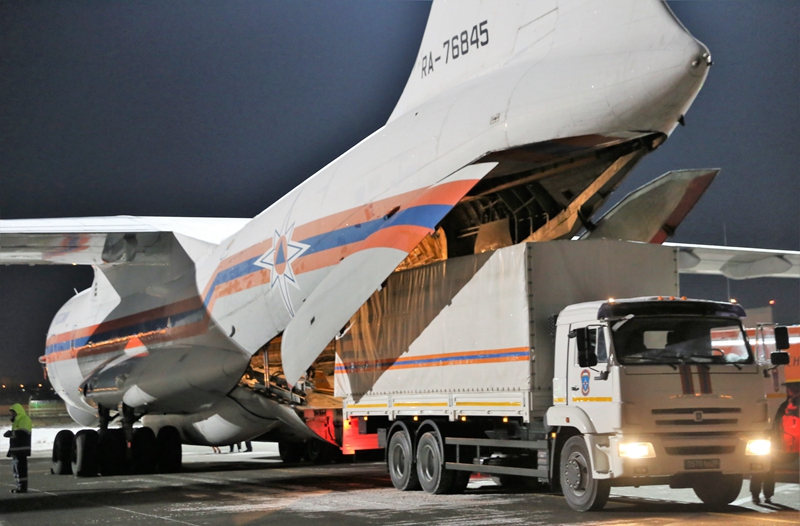
At the zhukovsky airport near Moscow, Russia, the staff loaded the medical aid materials provided by the Russian government on the transport plane (photo taken on February 8). Xinhua News Agency/Satellite Agency
Determine the pathogen within 8 days; The optimization of the detection kit was completed within 16 days, and the nucleic acid detection ability was improved from 300 to 20,000 per day; The national version of the diagnosis and treatment plan "iteration" seventh edition; Five kinds of Covid-19 vaccines were approved for clinical trials … The researchers set up special classes, and fought against the wall chart, racing against time and never sleeping.
From screening more than 10,000 kinds of drugs to determining an effective diagnosis and treatment plan, from summarizing the "three drugs and three parties" to adopting treatment methods such as convalescent plasma, the Party Central Committee pays attention to and supports every scientific research deployment; Every major breakthrough, the general secretary asked in detail.
General Secretary of the Supreme Leader made a special trip to the Military Medical Research Institute and Tsinghua University Medical College to inspect the scientific research work of prevention and control in COVID-19. He stressed: "At present, it still needs hard work to win the epidemic prevention and control people’s war, overall war and blocking war. The more we face this situation, the more we must insist on asking for answers and methods from science. "

On March 21st, in Belgrade, the capital of Serbia, Serbian President Vucic (left) greeted the members of China’s medical expert group to help Serbia fight the epidemic. A group of six medical experts from China arrived in Belgrade by special plane on the evening of 21st. Xinhua News Agency reporter Shi Zhongyu photo
Science is the fundamental solution to the "epidemic" in the national war; Overall planning is the winning way of crisis management.
When the mobile China presses the "pause button", a series of practical problems and potential influences come on:
In order to reduce the flow of people and stop the spread of the virus, it is a reasonable and necessary decision to extend the Spring Festival holiday. However, every day after the holiday, the national GDP will lose 150 billion yuan.
The longer the epidemic is stopped, the more difficult it is for the economy and society to restart and recover …
The epidemic should be controlled to death and the economy should be revitalized. At both ends of the scale, the weight is like a mountain.
On February 3, when the epidemic prevention and control was the most strenuous, the General Secretary of the Supreme Leader presided over the The Politburo Standing Committee (PSC) meeting, stressing: "Areas with particularly serious epidemic situations should concentrate on the epidemic prevention and control work, while other areas should do a good job in the prevention and control work, and make overall plans to do a good job in all aspects of reform, development and stability, especially the key tasks involved in building a well-off society in an all-round way and tackling poverty in a decisive battle."
In 2020, it is the final year of decisive battle to get rid of poverty. There is no way out to fulfill the promise of the party and the government to the people!
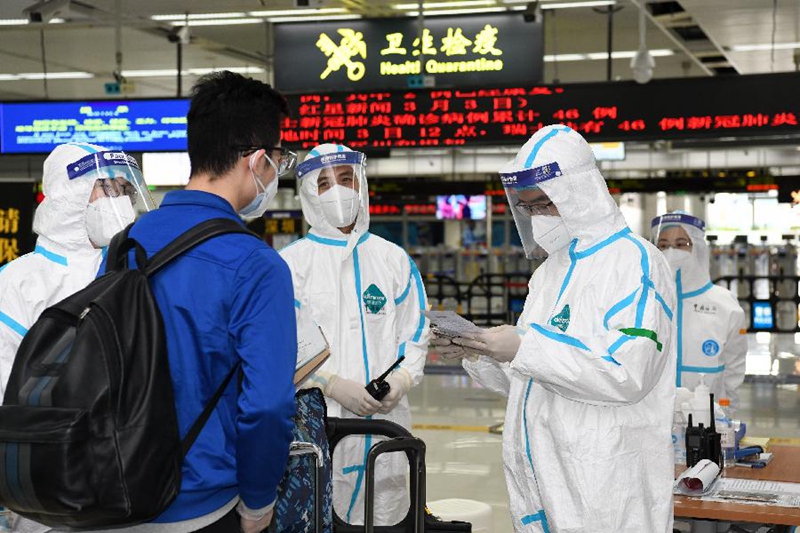
At the entry hall of Shenzhen Bay Port, customs staff checked the health declaration cards of inbound passengers (photo taken on April 3). Xinhua News Agency reporter Liang Xushe
On February 23rd, a special teleconference was held in the East Hall of the Great Hall of the People.
Facing the 170,000 cadres at or above the county level, the General Secretary of the Supreme Leader said frankly: "After the COVID-19 epidemic, it is a great challenge to integrate forces and fight against the epidemic in a short period of time; After the epidemic situation slows down, how to coordinate the prevention and control of the epidemic and resume work is also a great challenge. "
Epidemic prevention and control is related to life, and returning to work and production is related to livelihood.
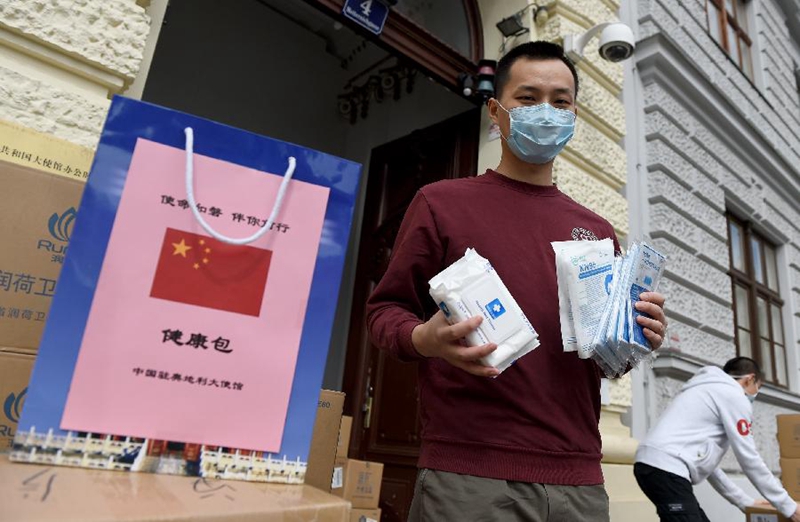
On April 17th, in front of the Chinese Embassy in Vienna, Austria, China student Lu Hui showed the epidemic prevention items in the "health package" distributed by the embassy. Xinhua News Agency reporter Guo Chenshe
From the implementation of accurate resumption of work and production at different levels to the introduction of phased and targeted tax reduction and fee reduction policies, from ensuring that "employees can get back, raw materials can be supplied, and products can be exported" to ensuring that agricultural production does not miss the farming season, from keeping the "rice bag" and "vegetable basket" to unblocking the foreign trade industrial chain and supply chain … Many township cadres said that even doing a good job in this year’s spring ploughing production, the Supreme Leader General Secretary is concerned and has made important decisions.
The spring breeze is warm and the earth is green.
In the satellite remote sensing picture, China in spring is lighting up-
Pearl River Delta, Yangtze River Delta and Beijing-Tianjin-Hebei, which account for more than 40% of China’s total economic output, are three major urban agglomerations. Hundreds of thousands of shops resume business every day and thousands of manufacturing enterprises return to work under the lights of Canruo Xinghe.
In the satellite positioning and navigation system, China in spring is running-
From the coastal areas to the inland areas, the movement lines formed by the running tracks of freight vehicles are multiplying. One flow curve contains infinite vitality for people to move smoothly and goods to flow smoothly.
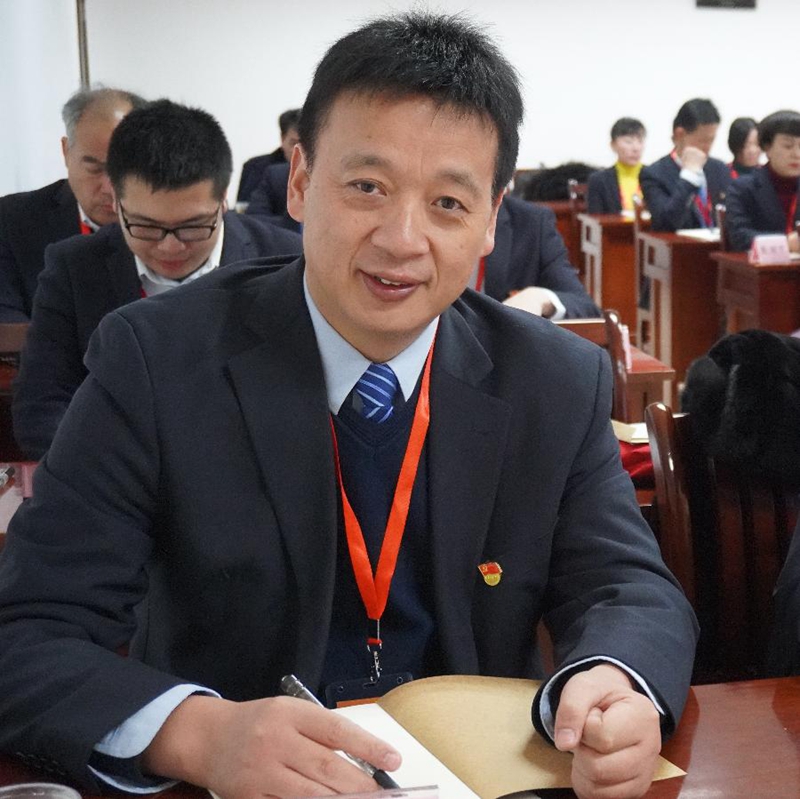
This is Liu Zhiming, president of Wuchang Hospital in Wuhan (photo). Xinhua news agency
At 13: 24 on March 19, the G4368 train slowly left Jingzhou Station. A trip to the "train for spring" was full of caring feelings of "holding hands and pulling hands", and 40,000 Hubei migrant workers were arranged to return to work in Guangdong.
Employment has introduced "caring" clauses, approval has achieved "remote connection", more accurate and effective regulatory policies have given the market "reassurance", tax relief has injected "cardiotonic agent" into enterprises … Central departments have intensively introduced new measures, injecting more "warm colors" into China’s economy.
Resume classes in batches, customize the return train, unify the "health code" and travel with confidence, and make time-sharing appointments for recovery tourism … All parts of the country actively respond to new changes and let China society return to "normal state" as soon as possible.
Factory workshop, busy production; In the countryside and fields, spring ploughing is busy.
On March 3rd, the People’s Government of Guizhou Province announced that Zheng ‘an, a county with deep poverty, had taken off its hat. This marks Zunyi’s overall poverty alleviation, and 8.12 million people in the old areas bid farewell to the history of poverty.
Three days later, the largest poverty alleviation meeting since the 18th National Congress of the Communist Party of China was held in the form of video conference. General Secretary of the Supreme Leader issued an order:
"Resolutely overcome the impact of the COVID-19 epidemic, resolutely win a comprehensive victory in the fight against poverty, and resolutely complete this great cause that is of great significance to the Chinese nation and mankind."
The spring rain in the south of the Yangtze River moistens things silently. In Ningbo, Zhejiang Province, the General Secretary of the Supreme Leader came to the front-line workers who resumed work and production, telling everyone to "ensure both production tasks and good health".
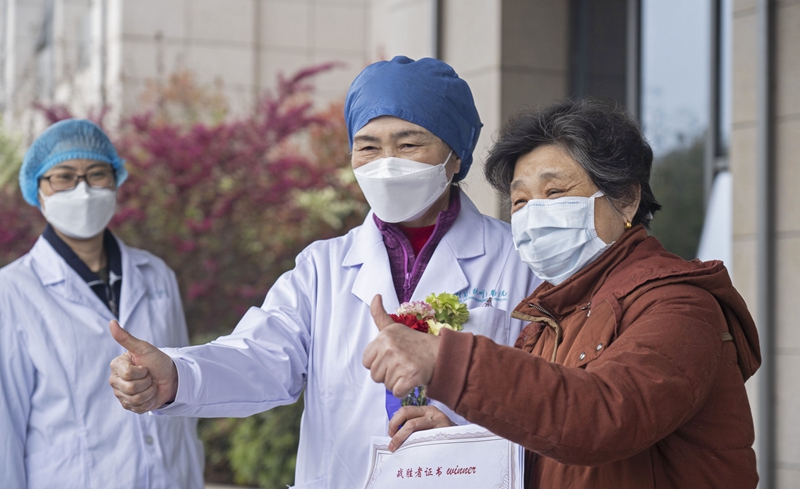
In the East Campus of Wuhan University People’s Hospital, Li Lanjuan (middle) took a group photo with the discharged patients (photo taken on March 16th). Xinhua News Agency reporter Cai Yang photo
Facing the expectation of the person in charge of small and medium-sized enterprises, General Secretary of the Supreme Leader said: "We have introduced a set of policy combination boxing, which will be adjusted in time and more targeted measures will be introduced as the situation changes."
On April 22, in the evening, the lights were on. Xi ‘an Datang City Pedestrian Street, General Secretary of the Supreme Leader who is visiting Xi ‘an, came here to learn about the recovery of the "night economy" on the spot.
The general secretary stressed that under the premise of scientific prevention and control of the epidemic, all kinds of shopping malls and markets should be promoted in an orderly manner and efforts should be made to restore normal life order.
On the eve of the two sessions of the National People’s Congress, General Secretary of the Supreme Leader opened the sixth local inspection tour since the COVID-19 epidemic, encouraging Shanxi to strive to overcome the adverse impact of the epidemic and make greater strides in high-quality transformation and development.
It is a kind of ability and a kind of determination to put it back and forth freely and advance and retreat.
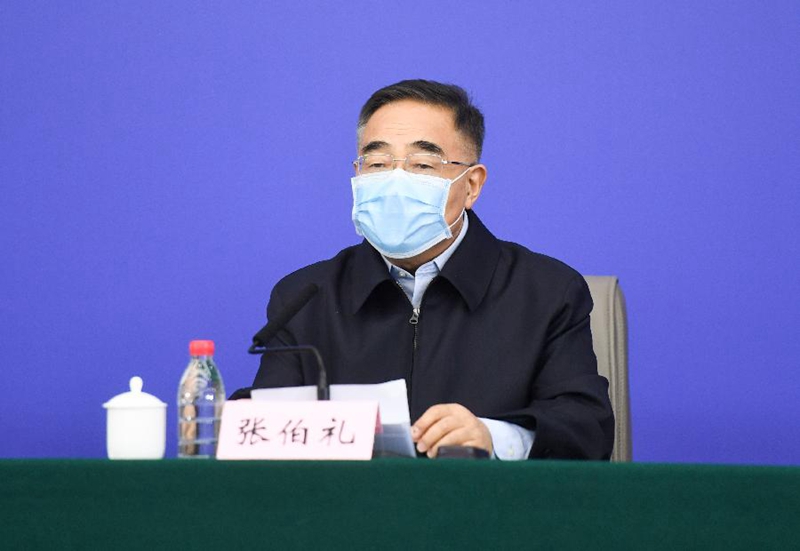
Zhang Boli answered a reporter’s question at the press conference held in Wuhan, Hubei Province (photo taken on March 23rd). Xinhua News Agency reporter Chen Yuhua photo
General Secretary of the Supreme Leader has repeatedly stressed: "We must strengthen our confidence and not be intimidated by problems and difficulties." "China is a big country with strong resilience, great potential and great room for manoeuvre."
Some foreign netizens feel that in the face of an unprecedented epidemic, with a population of 1.4 billion, water, electricity, heating, communication, supplies and social order, China has done it!
"Danger and opportunity always coexist, and overcoming danger is opportunity." Facing the market turmoil caused by the development of overseas epidemic and the serious impact on international economic and trade activities, the Supreme Leader General Secretary firmly declared China’s determination to maintain the openness, stability and security of the global industrial chain supply chain, and actively encouraged domestic enterprises to seize the opportunity of scientific and technological innovation and industrial upgrading.
Strong and orderly because of the time and the situation. Thousands of troops, if the command is determined.
The resumption of major investment projects has been accelerated, and the scale of migrant workers has been restored to about 90% of previous years. The "cloud service" and "cloud economy" have blossomed brilliantly … China’s economy and society have accurately recognized changes, responded scientifically, and actively sought changes, and difficulties have been quickly overcome, giving birth to new hopes in the vast land.
At 0: 00 on April 8, after 76 days of "closing the city", the heroic Wuhan was officially restarted.
On this landmark day, Standing Committee of the Political Bureau of the Communist Party of China Central Committee held a meeting, and the Supreme Leader General Secretary emphasized that it is necessary to accelerate the comprehensive recovery of production and living order in the prevention and control of normalized epidemic situation, solve the difficulties and problems faced by the resumption of work and production, strive to minimize the losses caused by the epidemic situation, and ensure the realization of the goals and tasks of building a well-off society in an all-round way and fighting poverty.
On April 17th, China released the economic data for the first quarter of 2020. Affected by the epidemic, the GDP in the first quarter decreased by 6.8% year-on-year. Since March, the main economic indicators have improved month by month, and the industrial added value and export growth rate turned from negative to positive in April. The epidemic has given birth to the rapid growth of new industries and formats, and China’s economy has shown great resilience.
On the same day, the Supreme Leader General Secretary presided over the Politburo meeting of the Chinese Communist Party. The meeting pointed out that the current economic development is facing unprecedented challenges, and it is necessary to fully estimate the difficulties, risks and uncertainties, earnestly enhance the sense of urgency, and grasp the work of economic and social development.
On April 29, the news that the two national conferences will be held came. The convening of this world-renowned grand meeting under the special background of normalization of epidemic prevention and control in COVID-19 fully shows that the CPC Central Committee with the Supreme Leader as the core is steadily steering the great ship China to break the waves.
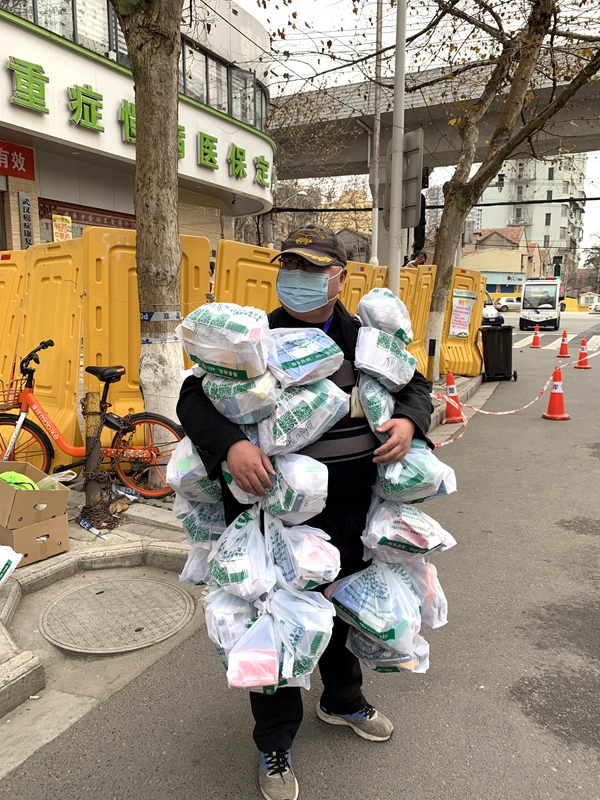
In Hankou Pharmacy, Huangshi Road, Jiang ‘an District, Wuhan City, Feng Feng, a grid member of Huimin Garden Community, hangs the medicine purchased for residents (photo taken on February 24). Xinhua news agency
Work together to fight the epidemic, share the same fate, and show China’s responsibility
"Human beings are a community of destiny. Unity and cooperation are the most powerful weapons to overcome epidemics that affect the safety of people in all countries. " -supreme leader
"Our war against the epidemic has ushered in the dawn of victory, but the situation overseas is deteriorating sharply." On the evening of March 12th, Wang Guo, a university teacher in Wuhan, kept a diary, adding another layer of worries-how are the students and friends from Thailand and Singapore who donated masks to the school?
With this in mind, he wrote with deep feelings: "Before the epidemic, there is no difference between’ us’ and’ them’, and people in every country are’ us’."
The whole world is as cool and hot as this. On the night when Wang Guo read and wrote these words, the Chairman of the Supreme Leader made an overseas call with UN Secretary-General Guterres:
"The occurrence of the COVID-19 epidemic once again shows that human beings are a community of shared destiny." "The international community must establish a sense of community of human destiny, look after each other and help each other, work together to meet risk challenges and build a beautiful home on earth."
The fortunes of mankind depend on each other. As early as the beginning of the outbreak, China put itself into the world frame of reference and shouldered the responsibility of a big country.
On January 12th, the World Health Organization announced that it had received the virus gene sequence information shared by China, which was published in the global influenza sharing database and shared by all countries.
"The epidemic is the devil, and we can’t let the devil hide." The words of the Supreme Leader’s Chairman are sonorous, conveying a frank attitude towards China and showing the fearless responsibility of China.
WHO Director-General Tan Desai said that China identified pathogens in a record short time and took the initiative to share the virus gene sequence with the international community in time.
China’s fight against the epidemic is also a fight for the world.
The Chairman of the Supreme Leader repeatedly said: "China upholds the concept of a community of human destiny, and is responsible for the safety and health of its own people, as well as the global public health cause."
After the outbreak, the Chairman of the Supreme Leader met with foreign leaders and heads of international organizations for four times, and made 51 calls. He sent messages of condolences to leaders of more than 10 countries and heads of regional organizations such as the European Union, and also exchanged letters with the Argentine President, replying to Bill Gates and Utah primary school students in the United States, introducing the key measures taken by the people of China to prevent and control the epidemic, thanking the international community for its support and help to China, expressing China’s positive will to provide assistance to all countries within its capacity, and joining hands with the international community.
Those who love others will always love them. At the most critical moment of the war in China, the international community expressed its warmth and goodwill and stood with the people of China.
More than 70 countries and international organizations have provided materials and other assistance to the people of China in their fight against the epidemic. Leaders of more than 170 countries, heads of more than 50 international and regional organizations and more than 300 foreign political parties and organizations expressed their condolences and support to China.
"A friend in need is a friend indeed!" Cambodian Prime Minister Hun Sen, Mongolian President Battulga and Pakistani President Alwi visited China successively. The Chairman of the Supreme Leader thanked them for their sincere and firm support.
The people of China will always remember that Russia, Belarus and other countries sent special planes to deliver urgently needed medical supplies to Wuhan at the first time; British and German chartered planes flying to Wuhan were loaded with medical supplies. Equatorial Guinea, an underdeveloped country that has been receiving aid for a long time, donated $2 million to China; Mongolia donated 30,000 sheep to China; Pakistan sent almost all its masks …
The people of China will never forget that the Chinese national anthem sounded in the Japanese Songshan Ballet, and millions of Sri Lankan people chanted prayers for the people of China. The beautiful poem "Mountains and rivers are exotic, and the moon is the same" crossed the ocean with love donations …
As Ban Ki-moon, former Secretary-General of the United Nations and chairman of Boao Forum for Asia, said, history bears in mind not only Socialism with Chinese characteristics’s institutional advantages, but also the joint responsibility of all countries in coping with the crisis.
COVID-19 epidemic is the common enemy of mankind. It took 67 days from reporting the first case to reporting the first 100,000 cases; It takes 11 days to report the second 100,000 cases; It took only four days to report the third 100,000 cases … Up to now, there have been more than 4.4 million confirmed cases worldwide!
China feels the same way when countries are hit hard by the epidemic.
Letters of condolence from the Chairman of the Supreme Leader were sent to the heads of state and government of Italy, Iran, South Korea, Spain, Serbia, Germany, France and other countries, as well as the heads of the European Council and the European Commission.
The valuable experience gained by the people of China in fighting the epidemic has been transmitted to five continents without reservation through a series of press conferences of the joint prevention and control mechanism in the State Council, press conferences of all provinces, autonomous regions and municipalities and video communication meetings of medical experts.
At 21: 00 local time on March 21st, Belgrade International Airport, Serbia. China’s anti-epidemic medical expert group assisting Serbia arrived by special plane, and at the same time, it brought the anti-epidemic materials urgently raised by the China government.
Standing by the gangway, Serbian President Vucic warmly welcomed the experts from China in a special way of touching elbows one by one, and gave a deep kiss on the five-star red flag to express his deep gratitude.
Russian President Vladimir Putin said on the phone with the Chairman of the Supreme Leader that China has set a good example for the international community by extending a helping hand to countries affected by the epidemic in time.
-Share epidemic prevention and treatment plans with 180 countries and more than 10 international and regional organizations around the world, and hold video exchange meetings on epidemic prevention and control with more than 160 countries and international organizations;
-More than 20 medical expert groups have been sent to provide much-needed anti-epidemic material assistance to more than 150 countries and international organizations;
-Donate US$ 50 million to WHO and make every effort to facilitate other countries to purchase medical protection materials in China.
Do your best and give generously.
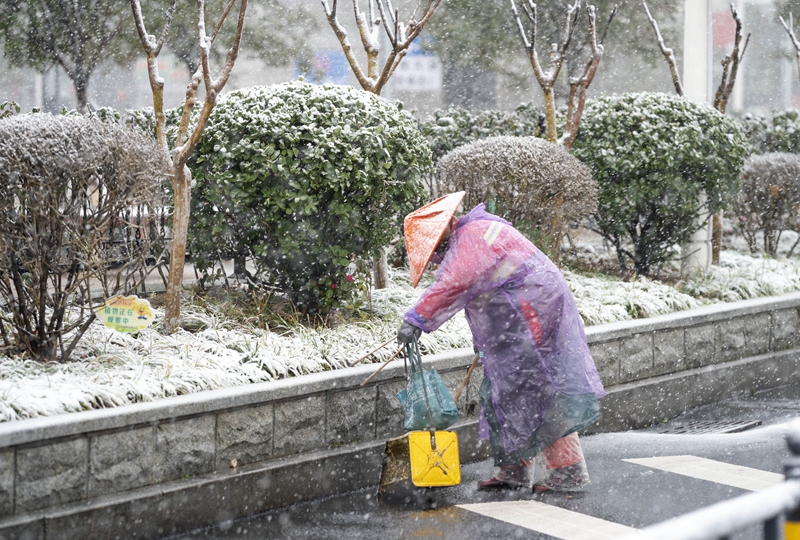
A sanitation worker works in the snow at Hankou Railway Station in Wuhan (photo taken on February 15). Xinhua News Agency reporter Cai Yang photo
Hassan Ahmadian, assistant professor of Middle East and North Africa Institute of Teheran University, said that China’s aid not only embodies the humanitarian spirit, but also is a responsible act of a big country.
The epidemic is both a big war and a big test. This is true for China and the world as well.
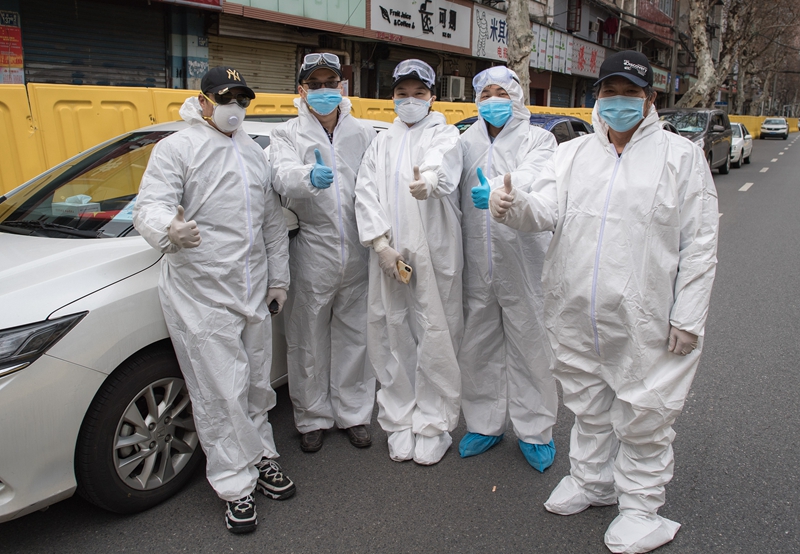
Volunteers Li Wenjian, Zhu Wei, Wang Ziyi, Wang Zhen and Yang Xuebin (from left to right) cheered for Wuhan (photo taken on February 29th). This volunteer team is responsible for transporting pregnant women who lack transportation to the hospital and become "ferrymen" of new life. Xinhua News Agency reporter Xiao Yijiu photo
The Chairman of the Supreme Leader profoundly pointed out: "The epidemic has spread in a wide range, at a high speed, and has had a great impact for a hundred years."
In view of the new situation and new problems of the increase of confirmed cases imported from abroad and the increase of asymptomatic infected persons, the General Secretary of the Supreme Leader, on the one hand, deployed to strengthen the care for overseas China citizens, on the other hand, timely switched the focus of epidemic prevention and control work to "import from outside and rebound from inside".
From strict customs quarantine enforcement to precise flight risk prevention and control, from implementing closed-loop management of entry personnel to intensifying screening of asymptomatic infected persons, from taking back China citizens from countries with severe epidemic to deploying "health packages" to countries with concentrated overseas students in China … A series of measures have effectively consolidated the hard-won achievements of the war "epidemic" and continued to defend the eastern defense line for the world war "epidemic".
In the face of a rare epidemic in a hundred years, where should mankind go? What kind of mission do countries shoulder?
On the evening of March 26th, the East Hall of the Great Hall of the People.
Images of leaders of various countries and heads of international organizations were uploaded on the huge TV wall. The leaders of the G20 held a special summit on COVID-19 by video conference for the first time in Riyadh, Moscow, Washington, Berlin and Brasilia.
"Resolutely fight a global war to prevent and control the COVID-19 epidemic", "effectively carry out international joint prevention and control", "actively support international organizations to play their role" and "strengthen international macroeconomic policy coordination"-Based on the practice in China, Chairman Supreme Leader put forward a four-point China initiative on comprehensively strengthening international cooperation and rallying strong joint efforts to overcome the epidemic.
"The public health crisis is a common challenge faced by mankind, and unity and cooperation are the most powerful weapons" … China’s voice won wider recognition and resonance in the face of the big exam of all mankind.
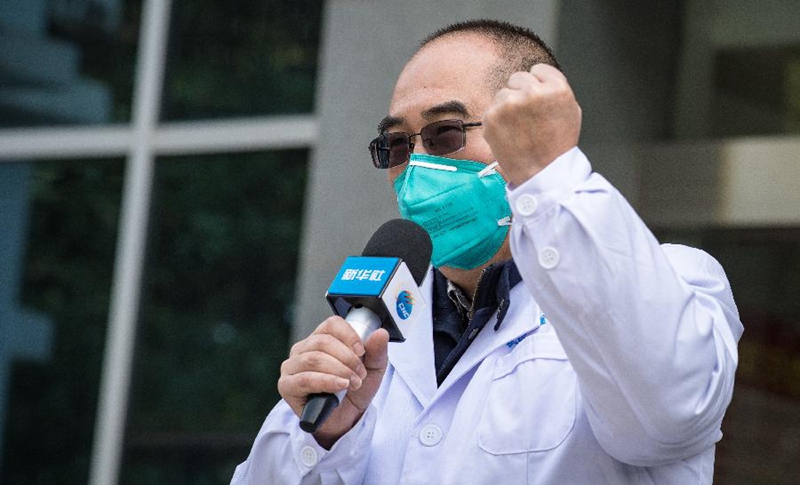
This is Zhang Dingyu, president of Wuhan Jinyintan Hospital (photo taken on January 29th). Xinhua News Agency reporter Xiao Yijiu photo
For the people, relying on the people, the Chinese nation has written an indelible heroic epic with great power.
"The Chinese nation has experienced many hardships in its history, but it has never been crushed. Instead, it has become more and more frustrated, constantly growing in hardships and rising from hardships." -supreme leader
"When the sea flows, you will show your true colors as a hero." General Secretary of the Supreme Leader quoted this sentence more than once when inspecting the epidemic prevention and control work in COVID-19.
"You really saved lives and loved the world." On March 10th, in the command center of Wuhan Huoshenshan Hospital, the General Secretary of the Supreme Leader connected with the representatives of medical staff working in the ward by video. "You are messengers of light, messengers of hope, the most beautiful angels and real heroes! The party and the people thank you! "
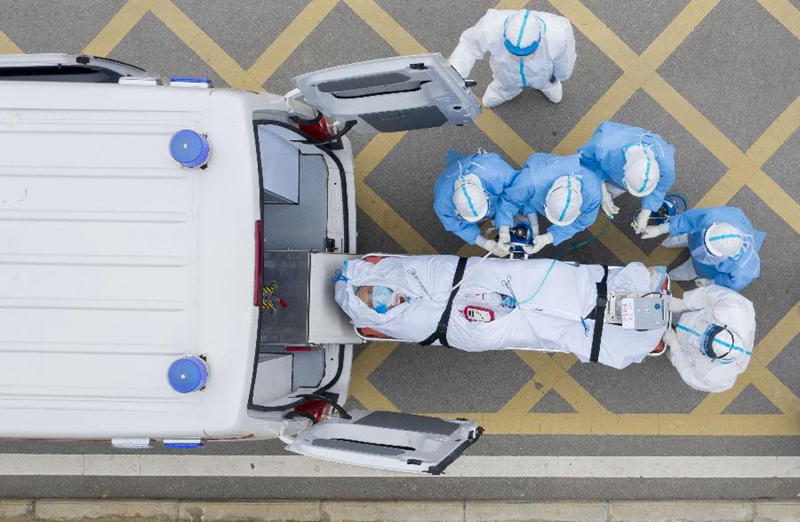
In the tongji hospital Sino-French New Town Campus affiliated to Huazhong University of Science and Technology, medical staff escorted a critically ill patient from COVID-19 who had just finished CT examination to get on the negative pressure ambulance (photo taken on March 6, drone photo). Xinhua News Agency reporter Cai Yang photo
The war "epidemic" was extremely tragic, and they defended their lives with their lives:
Liu Zhiming, the president of Wuchang Hospital, stayed in the intensive care unit until he was admitted to the intensive care unit. What he never forgot was how much patients received and whether the prevention and control of infection reached the standard. In order not to infect others, he told his colleagues "Don’t intubate me" …
Yin and Yang are separated forever, and the wife who is also treating the patient hears the news and can only chase the car of the funeral home and cry the name of her beloved over and over again …
Immediately after the outbreak, Wu Yaling, a member of the Hubei medical team who participated in Wenchuan earthquake relief and aided Africa in fighting Ebola virus, did not hesitate to submit an invitation letter and went to Vulcan Mountain Hospital.
Mother died suddenly. When the bad news came, she just wept silently, bowed deeply in the direction of home, and then returned to the patient.
There are too many tears to dry; There are too many brave, engraved on the hidden face.
84-year-old Zhong Nanshan crowded into the high-speed dining car and rushed to Wuhan.

This is an exclusive interview with Xinhua News Agency reporter by Zhong Nanshan in Guangzhou (photo taken on January 28th). Xinhua News Agency reporter Liu Dawei photo
The 73-year-old Li Lanjuan only sleeps for 3 hours every day. "I will not retreat if the epidemic does not retreat."
The 72-year-old Zhang Boli went to work on the third day after cholecystectomy. He only said: "My liver and gallbladder are in harmony, and I left my gallbladder here."
"I am deeply moved by the noble spirit of the vast number of medical staff who are selfless and forget their lives." The words of the Supreme Leader General Secretary are from the heart.
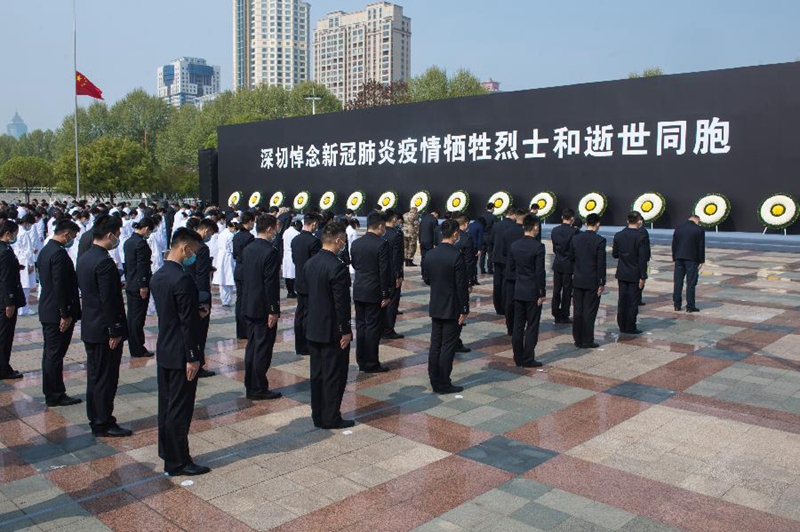
On April 4th, people observed a moment of silence in the mourning activities at the Yiyuan Square in Jiangtan, Hankou, Wuhan. On the same day, a mourning event was held in Wuhan to express deep condolences to the martyrs and deceased compatriots who died in the fight against the COVID-19 epidemic. Xinhua News Agency reporter Xiao Yijiu photo
Those handprints pressed on the invitation letter on New Year’s Eve, the scars branded on the cheeks by masks, the sweat-soaked backs under protective clothing, and the secretly written and quietly hidden suicide notes … all remain in the memory of the motherland and the people.
"You are all wearing protective clothing and masks. I can’t see your true faces. However, you are all the cutest people in my mind! " The words of the Supreme Leader’s General Secretary inspired the soldiers in white.
Courage and sacrifice are hard to count in this war; Ordinary and great, incisively and vividly in this big exam.
On March 10th, the Party and Mass Service Center of Donghu New Town Community in Wuhan pulled up a folding chair, and the General Secretary of the Supreme Leader sat down and had a face-to-face cordial conversation with community workers, grassroots police, doctors in health service stations, sinking cadres and volunteers.
The general secretary said: "Everyone worked tirelessly and silently day and night to serve the masses, and made important contributions to curbing the spread of the epidemic and ensuring people’s lives, showing the spirit of Wuhan party member and cadres who are not afraid of sacrifice, have the courage to take responsibility, take care of the overall situation and are willing to contribute."
"If we don’t sleep, the city won’t lose."
On the day and night of Wuhan’s "city closure", there are party member and cadres charging in front, police officers on duty day and night, community grid workers on call, sanitation workers cleaning at designated points, and volunteers’ love relay … These unknown people are guarding the lights and propping up the lifeline of a city.
March 10th, East Lake New Town Community, Wuhan. Residents who have been quarantined at home for 48 days saw the arrival of the General Secretary and leaned out from balconies and windows to pay their respects. Some waved national flags and shouted, "Come on, China! Come on, Wuhan! "
"Let’s cheer together and stick to it!" This scene has been viewed hundreds of millions of times, and the voice of the general secretary echoes with the voice of the people. "The party and the people thank the people of Wuhan."
The people, in the heart of the supreme leader general secretary, are heavy. Thanks to the people again and again, it shows the childlike feelings of "people first", and it is also the magic weapon to win the national war against "epidemic".
Drosten, a German virologist, said that we really need to learn from China and thank the China government and the people of China who are dedicated and collectivist.
Zhang Dingyu, president of Wuhan Jinyintan Hospital, shed tears at the moment when the news of lifting the "closed city" in Wuhan came.
When the disaster came, he didn’t take care of his worsening frostbite, and he didn’t have time to look after his wife who was diagnosed with COVID-19.
When the storm receded, what he remembered most were the lives that had fought tenaciously against the disease, the volunteers who shuttled patients and samples, the patients who came to donate blood after recovery, and the "isolated virus does not isolate love" that kept flashing on the mobile phone …
Today, the praise of the Supreme Leader General Secretary comforts the scars of life and warms the land of Jingchu: "The people of Wuhan have demonstrated the strength of China and the spirit of China with their own practical actions, highlighting the feelings of the Chinese nation in the same boat and helping each other."
The disaster will eventually pass, and the feelings will remain in my heart.
Reporters who went deep into the "red zone" could not forget it, and doctors who fought all night cried and said, "I’m sorry, I tried my best"; The patients in Fangcang Hospital can’t forget it. Some people even lost their loved ones, and they still shed tears to cheer for everyone. Hundreds of millions of netizens can’t forget that critically ill patients used up their last strength and wrote "My body donated to the country" …
The party and the country can’t forget that 1.4 billion people, regardless of age or occupation, chose to defend their country and give up their homes for the country, and turned "impossible" into "sure" with the overwhelming power.
In the anti-epidemic group portrait published by Time magazine in the United States, the hands of Beijing takeaway rider Gao Zhixiao are particularly eye-catching. This 32-year-old young man rides more than 100 kilometers every day, and delivers 60 or 70 bills at most. One hand sends out not only the urgent needs of many families, but also the hope of a country carrying heavy burdens.
"The people are the real heroes." General Secretary of the Supreme Leader praised with deep affection. The people are the source of strength for this country to continue to write miracles and move towards victory.
As the General Secretary of the Supreme Leader said: "The Chinese nation has experienced many hardships in its history, but it has never been crushed. Instead, it has become more and more frustrated, constantly growing and rising from hardships."
Growing up in tribulation and rising from tribulation-this spirit is contained in the hardships of fighting foreign aggression for independence and liberation, honed in the struggle of socialist construction and unremitting exploration of reform and opening up, and also shines in the tempering of fighting SARS, earthquake relief and fighting COVID-19 epidemic.
At 0: 00 on April 8.
Wen Rui, a lighting maintenance worker in wuhan yangtze river bridge, once again walked out of the board room under the bridge and watched the bridge lights he had guarded for more than 70 days.
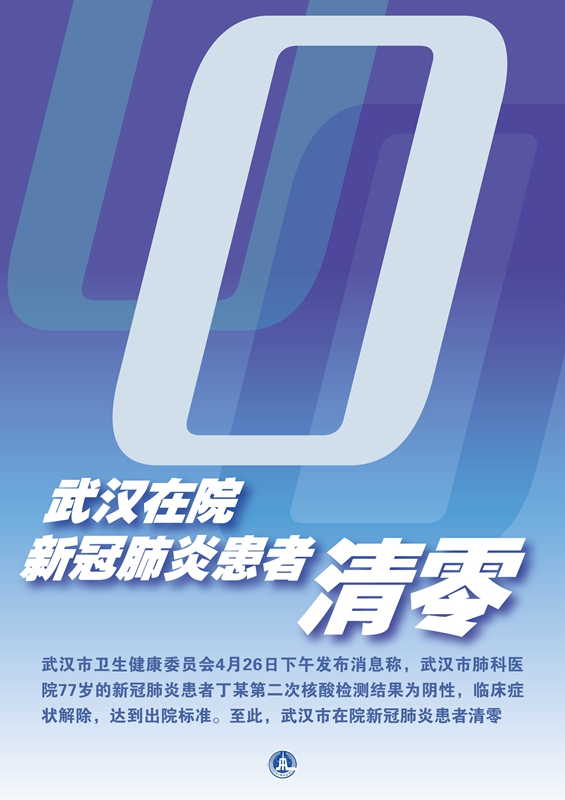
Poster: COVID-19 patients in Wuhan hospital are cleared. Prepared by Xinhua News Agency reporter Chen Congying
The words "Wuhan restarts, not to bear the spring" light up on time, and the light show "Hero City, Hero People" lights up the night sky of three towns in Wuhan.
At the same time, at the intersection of Wuhan West Expressway, with the first passenger car leaving, railways, civil aviation, water transport and highways resumed operation.
The bells of Jianghan Pass spread to all directions. In front of the square, between buildings, in the live video, and in the circle of WeChat friends, "Wuhan will win!" Long live the motherland!’ Welcome a brand-new day with this city.
In a corner of the city, a clear cry rises in the delivery room of Hubei Maternal and Child Health Hospital, which is the 5108th new life born in this hospital since the city was closed.
"People are in the city, and they are endless!"
It took more than one month to initially curb the spread of the epidemic, about two months to control the daily new cases in the local area within single digits, and about three months to achieve decisive results in the defense of Wuhan and Hubei. For a big country with a population of 1.4 billion, such achievements are hard to come by!
The majestic Yellow Crane Tower witnessed the unyielding struggle of a city; The surging waters of the Yangtze River are surging with the surging blood of a nation.
Never forget your initial intention, never forget your mission, and achieve historical progress in the history exam.
"This epidemic is a big test of China’s governance system and ability. We must sum up experience and learn lessons." -supreme leader
The memory of Tomb-Sweeping Day in the year of Gengzi is unforgettable.
At 10 o’clock on April 4, 2020. In front of Huairentang, Zhongnanhai, the supreme leader and other party and state leaders stood in silence wearing white flowers and looking dignified. Together with the 1.4 billion people of China, they deeply mourned the martyrs and compatriots who died in the COVID-19 epidemic.
In 3 minutes and 180 seconds, the alarm rang through the north and south of the great river, inside and outside the Great Wall, and the country sent off the sacrificed heroes with the highest memorial ceremony and mourned the compatriots who died of illness.
The COVID-19 epidemic has infected more than 80,000 people and killed more than 4,600 people.
The General Secretary of the Supreme Leader profoundly pointed out: "This epidemic is a big test of China’s governance system and ability. We must sum up experience and learn lessons."
Facing the big exam, the Communist Party of China (CPC)’s political nature is moving.
On March 2nd, a special swearing-in ceremony was held in Guangzhou and Wuhan.
Through the video, Academician Zhong Nanshan, who has been a party member for 55 years, said to Li Yingxian, a frontline nurse who joined the party in FireWire: "Now is the time when Communist party member needs to stand up. I have seen greatness in your ordinary work."
Rush up at the critical moment and get out at the critical moment. In the face of this big test of life and death, a total of 440 thousand people across the country submitted applications for joining the party.
On the front line of anti-epidemic, a total of 244 thousand temporary party organizations have been established; 396 party member and cadres were killed (sacrificed) in the line of duty.
The clank oath of "ready to sacrifice everything for the party and people" resounded through China, and bright red party flag fluttered high in the front line of fighting the epidemic.
Facing the big exam, Socialism with Chinese characteristics’s institutional advantages are more prominent.
At the command, thousands of miles rushed to help; Unified scheduling and coordinated promotion; As General Secretary of the Supreme Leader pointed out: "The fundamental reason why China’s epidemic prevention and control and resumption of work and production can be vigorously promoted is that the leadership of the party and the advantages of China’s socialist system have played an unparalleled and important role."
In the face of the big exam, the majestic power of concentric up and down is unstoppable.
In the reply to the students of Tibet University Medical College who were internship in Shougang Hospital, General Secretary of the Supreme Leader encouraged them to follow the example of angels in white in the "epidemic" and strive to be good doctors trusted by the party and the people. With a strong heart, when replying to all the post-90s party member of Peking University Aid Hubei Medical Team, the General Secretary of the Supreme Leader encouraged the vast number of young people not to be afraid of the wind and rain, to shoulder heavy burdens bravely, and to let youth bloom in the places where the party and the people need it most; Always miss, in the reply to all community workers in Donghu New Town Community of Wuhan, the General Secretary of the Supreme Leader has high hopes, hoping that they will make new contributions to completely winning the people’s war, overall war and blocking war against the epidemic.
On the eve of May 1st International Labor Day, I wrote back to encourage the working people. On the occasion of May 4th Youth Day, I sent a message to the young people in the new era. On the occasion of the International Nurses’ Day, I extended my holiday congratulations and sincere condolences to the nurses all over the country … The cordial concern of the Supreme Leader General Secretary inspired people and inspired their fighting spirit.
There is a little light, a little light, and a force. The 1.4 billion people, with the great love of their home country and the national justice of "striving for one place", have opened a safe mode for the whole people to fight the epidemic.
The big exam is like a mirror, which shows advantages and exposes shortcomings.
In January 2018, at the opening ceremony of the seminar on studying and implementing the spirit of the 19th National Congress of the Communist Party of China, the General Secretary of the Supreme Leader listed 16 specific risks in eight aspects, and explicitly mentioned: "Major infectious diseases like SARS should always be vigilant and strictly guarded."
In January, 2019, at the seminar where leading cadres at the provincial and ministerial levels insisted on the bottom line thinking and focused on preventing and resolving major risks, the General Secretary of the Supreme Leader pointed out that in the face of the turbulent international situation, complex and sensitive surrounding environment and arduous and arduous tasks of reform, development and stability, we must always be highly vigilant, not only against the "black swan" incident, but also against the "grey rhinoceros" incident.
The sober judgment of the CPC Central Committee is by no means alarmist. At the key node of building a well-off society in an all-round way and fighting poverty, the epidemic situation in COVID-19 has sounded the alarm.
Hospital bed reserves are insufficient, primary medical care is obviously weak, the distribution of donated materials is not smooth, and the prevention and control notices are inconsistent … In the voice of doubt, China’s shortcomings in major epidemic prevention and control system and public health emergency management system need to be filled.
Some are afraid to take responsibility, unwilling to take responsibility, some are confused and have no ideas in their work, and some are still engaged in formalism and bureaucracy … In the fight against the epidemic, the problem that a few cadres are difficult to stand the test and lack of working ability is very prominent.
General Secretary of the Supreme Leader pointed out: "After every disaster, we should become smarter."
Summing up experience and lessons in the war "epidemic" and focusing on long-term stability is the proper meaning of promoting the modernization of the national governance system and governance capacity.
General Secretary of the Supreme Leader clearly pointed out from a strategic and overall perspective that in view of the shortcomings and deficiencies exposed by this epidemic, we should pay close attention to filling shortcomings, plugging loopholes, strong and weak items, persisting in this, perfecting this perfection, establishing this establishment, implementing this implementation, perfecting the system and mechanism of major epidemic prevention and control, and improving the national public health emergency management system.
"The construction of dikes and seawalls and the construction of earthquake-resistant houses should prepare for the once-in-a-century disaster. The investment in public health is also rather prepared than used, not available and not prepared. "
Insist on planning ahead and thinking at the bottom line, General Secretary of the Supreme Leader stressed that it is necessary to strengthen strategic planning and forward-looking layout, adhere to the combination of peacetime and wartime, improve the system and mechanism of major epidemic prevention and control, improve the public health emergency management system, push the work force to sink to the front line, optimize the production capacity layout and guarantee of important emergency materials, and ensure that major risks in the public health field are discovered, warned early and handled well.
Be prepared, for the country. General Secretary of the Supreme Leader further pointed out that we should always be cautious in treading on thin ice and keen to see Ye Zhiqiu. We should not only be highly vigilant and guard against major risks in our own areas, but also pay close attention to major risks in the overall situation.
Focus on the fundamentals and plan for the long term. General Secretary of the Supreme Leader profoundly pointed out: "Man and nature should live in harmony, and once human activities exceed the natural carrying capacity, they will be retaliated." Practicing the concept of green development is not only related to the sustainable development of economy and society, but also to the harmonious coexistence between man and nature.
Those who observe the situation are wise, and those who follow the trend are wise. In the face of this major global crisis and the common war of all mankind, the voice of the Supreme Leader General Secretary is firm and powerful: "Only with the joint efforts of all mankind can we win the war."
Strive for Corning in the world and China!
General Secretary of the Supreme Leader’s earnest warning is still in my ears:
"Today’s world is experiencing a great change that has never happened in a century. China is in a critical period to realize the great rejuvenation of the Chinese nation. Our party is leading the people in a great struggle with many new historical characteristics. The situation and environment are changing rapidly, the tasks of reform, development and stability are heavy, contradictions and risks are challenging, and the test of our party’s governance is unprecedented."
"The more severe and complicated the development environment, the more we must unswervingly deepen reform, improve all aspects of the system, improve the governance system, promote the better transformation and integration of system construction and governance efficiency, and be good at using institutional advantages to cope with the impact of risk challenges."
At the meeting held in The Politburo Standing Committee (PSC) on May 14th, General Secretary of the Supreme Leader pointed out that the current situation of epidemic prevention and control in China is generally good, while the situation of epidemic abroad is severe and complicated, and the task of preventing epidemic rebound in China is still arduous. We must resolutely overcome paralysis, war-weariness, luck, and relaxation, and continue to pay close attention to the work of external defense input and internal defense rebound. We must never let the hard-won achievements in epidemic prevention and control be wasted, ensure the completion of the decisive battle to get rid of poverty, and build a well-off society in an all-round way.
Summing up the experience and lessons from the great war and drawing wisdom from the big exam, the Chinese nation will certainly be able to turn danger into opportunity and move forward rain or shine! (Reporter: Zhao Cheng, Huo Xiaoguang, Zhang Xudong, Wu Jing, Chen Fang, Zhao Chao, Liu Hua, An Bei, Lin Hui, Zhu Jichai, Jianqiang Liang)
